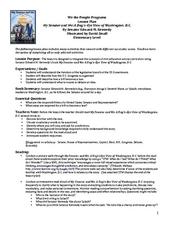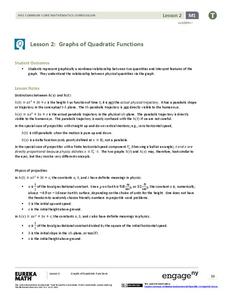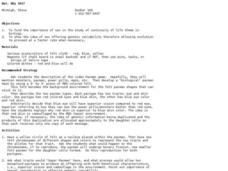LABScI
Vision Lab: The Eye
Our bodies have some amazing capabilities, but there are some limitations. Explore the limitations of the human eye through the eighth lab activity in a series of 12 biology lessons. Individuals measure their own peripheral vision and...
Curated OER
My Senator and Me: A Dog's-Eye View of Washington, D.C.
Although this legislative process lesson is designed to accompany a specific text, it is valuable independently. Young learners participate in a picture walk (worksheet included) through My Senator and Me: A Dog's-Eye View of Washington,...
EngageNY
Tides, Sound Waves, and Stock Markets
Help pupils see the world through the eyes of a mathematician. As they examine tide patterns, sound waves, and stock market patterns using trigonometric functions, learners create scatter plots and write best-fit functions.
EngageNY
Graphs of Quadratic Functions
How high is too high for a belly flop? Learners analyze data to model the world record belly flop using a quadratic equation. They create a graph and analyze the key features and apply them to the context of the video.
Curated OER
Skulls Tell It All
Skulls tell it all, and with this lesson plan, you will tell it all to your class! Youngsters view animal skulls, analyzing the shape of teeth and the placement of the eye sockets. They associate these adaptations with the types of food...
Curated OER
Naked to the Eye
Sixth graders study microorganisms. In this microorganism instructional activity, 6th graders explore the form and function of these organisms. Students use magnification during experiments on bread.
Curated OER
Vision and Optics: Light and Lenses
Students gain a conceptual comprehension of the functioning of the Human Eye in relation to optics and optical vision correction. They explore optics with light sources and various lenses, relating these to visual acuity, accommodation,...
Curated OER
How We See
Students study how images they see are transmitted to the brain. In this sight lesson students complete several activities that have to do with visual pathways and field defects.
Curated OER
Structure and Function
Structure and Function
SynopsisStudents choose some biological object, examine its structure, and identify or speculate on one particular function. Next they create a blueprint of the object, focusing on the particular function. Then...
Curated OER
Benham's Disk
Seeing is believing! Or is it? With this simple experiment, young scientists can explore the concept of visual perception. Attach Benham's disk to a rotating appliance such as a hand drill; As it spins, the black lines appear to be...
Cornell University
Thinking with the Eyes
Objects are larger (or smaller) than they appear! Scholars use a laboratory investigation to explore the difference between resolution and magnification. The activity allows them to calculate the size of the field of view of their light...
Curated OER
What is the Anatomy of the Visual System?
Students research the structures and functions of the eye. In small groups they dissect a model of the human eye, identify structures of the eye, and describe the functions of the photoreceptors.
Curated OER
Developing Coordination Skills and Pencil Control Using Mouse Hockey
Students explore motor skills by participating in a drawing activity. In this hand coordination activity, students utilize activity sheets in which they drag their pencil in a specific direction quickly and efficiently. Students utilize...
Curated OER
Flowers: Form and Function
Learners recognize and name the parts of a flower. They explain the function of each part of a flower. Students list the steps that occur for sexual reproduction of a plant to take place. They recognize and name the male reproductive...
Curated OER
Structure and Function of Bulbs, Corms and Rhizomes
Students explore the concept of philanthropy and why people give. They investigate the importance of the tulip to Holland and the tradition of giving flowers away. They begin to explore the life cycle of tulips and dissect a bulb to...
Curated OER
What are Igneous Rocks and How are They Formed?
Crystals form before your very eyes! What sixth grader wouldn't enjoy this lesson on igneous rock formation? Using hot Salol, junior geologists observe the crystal formation process as the material cools. This comprehensive lesson plan...
Curated OER
Dissection Scramble
Students discover the anatomy of a human body by dissecting a cow's eye. For this animal dissection lesson, students identify the structure of an eyeball by cutting open a cow eye and observing the insides. Students participate in an...
Curated OER
Variation and Heredity
Junior geneticists tally eye color and height in their lab groups. They examine certain traits in soybean and corn seedlings. For each activity, they gather data and learn about continuous and discontinuous genetic variation. In another...
Curated OER
Close Observation: Coins
Integrate math, science, and speaking/listening with a collaborative hands-on activity. Each group works with a single penny, examining it with the naked eye and recording observations. Repeat using magnifying glasses. Then repeat with a...
American Museum of Natural History
Fighting Dinos
A famous fossil of fighting dinosaurs holds as many questions as answers. Scholars first analyze the fossil itself by virtually highlighting the specific bones of the dinosaurs and read about their function and importance. They then test...
Cornell University
Discovering Enzymes
Explore the function of enzymes through a series of lab investigations. Learners use household enzymes such as hydrogen peroxide to model the role of enzymes. The enzymes break down proteins with and without a catalyst.
Curated OER
The Landscape Through Geographer's Eyes
Students examine different types of landscapes through a geographer's eye. Using a city block or a suburb, they organize their thoughts and take notes to survey a site. They discuss what they have seen and write about how looking at...
Curated OER
But, Why Sex?
Students investigate the importance of sexual reproduction in evolution. In this sexual reproduction lesson plan, students simulate species with two traits: eye and skin color. They determine what characteristics are beneficial for the...
Curated OER
Reflection of Light and Mirrors
Students address common misconceptions concerning reflection, light and mirrors. They investigate light reflection in mirrors and determine how light is transferred to the eye. In addition, they make predictions and then test them...

























